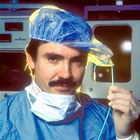 34 years ago, Andreas Gruentzig performed the first coronary angioplasty. Rather than cutting open the chest, sawing through the sternum and sewing a bypass conduit (harvested from the leg or internal mammary artery) into the coronary artery, he elegantly threaded a balloon catheter to the blockage through a small incision in the femoral (groin) artery, in an awake patient. He then inflated the balloon, compressing the plaque against the arterial wall and opening the artery. The procedure was a total success and his first patient, Adolph Bachmann, is alive and well today! (see video clip: ” The 1st Angioplasty”.)
34 years ago, Andreas Gruentzig performed the first coronary angioplasty. Rather than cutting open the chest, sawing through the sternum and sewing a bypass conduit (harvested from the leg or internal mammary artery) into the coronary artery, he elegantly threaded a balloon catheter to the blockage through a small incision in the femoral (groin) artery, in an awake patient. He then inflated the balloon, compressing the plaque against the arterial wall and opening the artery. The procedure was a total success and his first patient, Adolph Bachmann, is alive and well today! (see video clip: ” The 1st Angioplasty”.)
But more importantly than just inventing angioplasty, Gruentzig invented a method for treating patients non-surgically, from the inside-out! What Gruentzig said was:
“Whatever becomes of the method, I have left one mark on medicine: I have shown that man can work therapeutically within the coronary arteries themselves in the face of an alert comfortable patient.”
 Gruentzig’s proclamation was a fitting answer to a thought expressed exactly two centuries earlier!
Gruentzig’s proclamation was a fitting answer to a thought expressed exactly two centuries earlier!
Englishman John Hunter, considered the founder of “scientific surgery” and the first physician to treat an aneurysm successfully, wrote the following in his 1777 treatise, “The True Principles of Surgery”:
“This last part…namely operations…is a tacit acknowledgement of the insufficiency of surgery. It is like an armed savage who attempts to get that by force which a civilized man would get by stratagem.”
So, rather than requiring the “armed savagery” of open surgery, in the 21st century, Gruentzig’s “civilized stratagem” is now being applied to areas of medicine that he could only have imagined.
For example, diseased aortic valves, previously only repaired via open heart surgery, are now successfully being replaced via catheter-based technologies.
There are two major percutaneous (i.e. nonsurgical) devices currently being studied as an alternative to surgically replacing aortic valves in the heart: the Sapien valve, manufactured by Edwards Lifesciences and the CoreValve, manufactured by Medtronic. The PARTNER trial one-year results of the Sapien valve, showed a 46% relative risk reduction in mortality over medical therapy for patients who were too sick to have open surgery, as reported last October in the New England Journal of Medicine.
So today, the FDA conditionally approved changes in the just-beginning U.S. trial for Medtronic’s percutaneous CoreValve. (By the way, the CoreValve has been approved in Europe since March 2007 and has since been implanted in thousands of patients.) Rather than requiring that the company test their device against “best medical therapy”, the FDA agreed with Medtronic that it would not be ethical to randomize patients to medical therapy vs. the percutaneous valve since the data from the PARTNER trial was so compelling as to the advantages of the percutaneous valve.
A further boost to the CoreValve trial is that the FDA also approved inclusion of the subclavian approach. Some patients do not have large enough femoral arteries to accept the equipment, or their femoral arteries are too diseased. So now the subclavian artery can be used, although it is somewhat more invasive, and the number of patients who might benefit from this therapy is significantly expanded.



